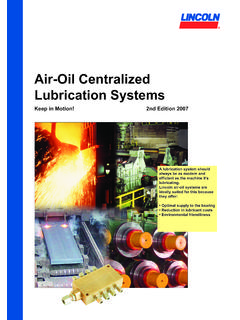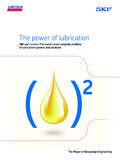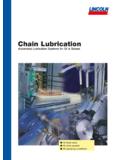Transcription of Dangers of Oil Mist in Gas Compressor Stations
1 Dangers of Oil Mist in Gas Compressor StationsChallengeLubrication oil is often circulated through natural gas compressors to provide cooling and to prevent engine wear. The lube oil system is pressurized and as a result there is a high risk potential for leakage. When leaks occur the lube oil often sprays into the atmosphere producing an oil mist or atomized cloud. The mist not only creates an expensive, time consuming clean-up project but more importantly can produce highly toxic smoke or burst into explosive flame upon contact with hot surfaces or engine spark is not uncommon that gas transportation companies can report dozens of oil leaks per year in a single gas compression station facility and some of those leaks break into fire causing significant damage and production loss. Numerous industry studies have verified that both smoke and oil mist often precede flame and either may obscure or blind some optical flame detectors preventing fire warning and potentially leading to Safety s Millennium Oil Mist Detector - Air Particle Monitor (APM) is an infrared optical detector that monitors ambient air for the presence of particulate matter such as dust and oil mist; and products of combustion like smoke and carbon.
2 The principle of operation is based on the reflection of infrared radiation by airborne particles. Field adjustable zero level of obscuration as well as multiple sensitivity settings allows for fine tuning within specific application conditions to optimize performance and eliminate false alarms. Sensor performance is not effected by high volume air velocity. Responses from the APM include actuation of relays, LED indicators, LED alphanumeric display and 4 20 mA DC output for transmitting information to other Millennium Oil Mist Detector is ideally suited for the previously described natural gas Compressor station system where lube oil is used to cool and lubricate compressors in pipeline or processing advanced detection system provides Compressor buildings with fast, accurate detection of lube oil leaks manifested by smoke or oil mist, providing a proven source of protection for plant and personnel.
3 Natural gas transportation companies worldwide and several offshore platform operators have successfully implemented the Millennium Oil Mist Detector - Air Particle Monitor (APM) to supplement protection provided by optical flame detectors and gas sensors. PMS - UncoatedPMS - CoatedCMYKGreyBlackEnclosed Gas Compressor BuildingApplication Data SheetOil & GasMillennium Oil Mist Detector (APM) Explosion proof Class 1, Division 1 -- Suitable for hazardous locations 4 20 analog signal and Form C mechanical relays -- Easily integrates into existing systems Not Effected By High Air Volume or Air Velocity -- Ideal for duct installations Low Power Consumption -- For use with 12 or 24V DC systems Field Adjustable Sensitivity -- Settings for low/medium/high concentrations Remote Sensor -- Separation of up to 2,000 feet, several mounting configurationsDownload Product Data SheetOil & GasFGD_ADS_OilGas_Oil_Mist_Detection_Gas _Compressor_Stations 2013 Emerson Process Management.
4 All rights Emerson logo is a trademark and service mark of Emerson Electric Co. Rosemount Analytical and Net Safety Monitoring are marks of Emerson Process Management family of companies. All other marks are the property of their respective contents of this publication are presented for information purposes only, and while effort has been made to ensure their accuracy, they are not to be construed as warranties or guarantees, express or implied, regarding the products or services described herein or their use or applicability. All sales are governed by our terms and conditions, which are available on request. We reserve the right to modify or improve the designs or specifications of our products at any time without Process ManagementFlame and Gas DetectionNet Safety Monitoring Hopewell Place NECalgary, Alberta, Canada T1Y 7J7T + 1 (403) 219 0688T 1 866 FIREGASF +1 (403) 219 - UncoatedPMS - CoatedCMYKGreyBlack















